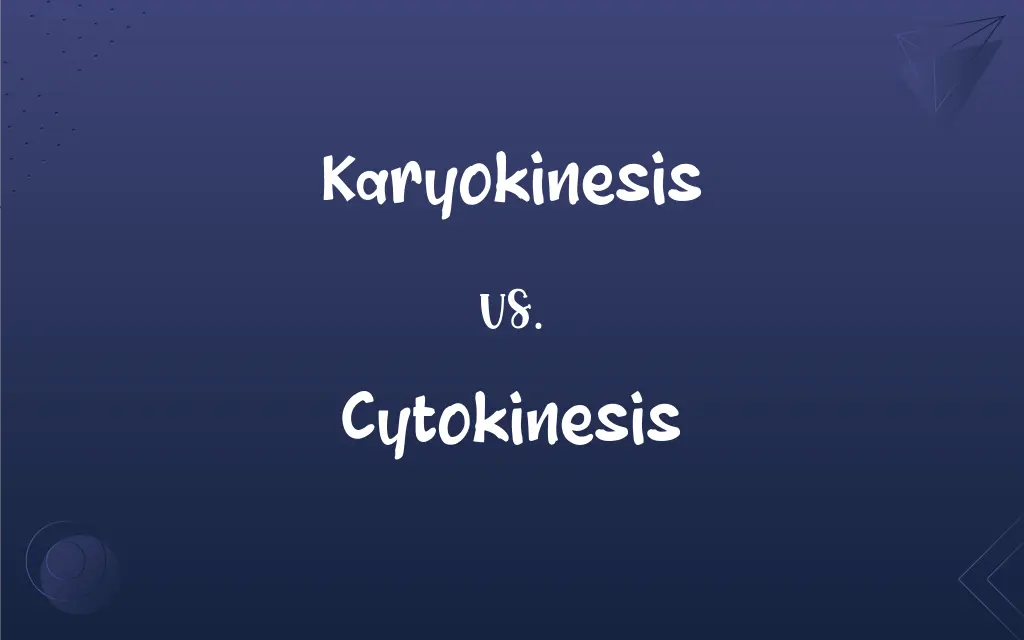Karyokinesis vs. Cytokinesis: What's the Difference?
Edited by Janet White || By Harlon Moss || Updated on October 5, 2023
Karyokinesis involves the division of a cell's nucleus, while cytokinesis divides the cell's cytoplasm, each facilitating cell replication. Both are vital stages in cell division, occurring sequentially in the cell cycle.

Key Differences
Karyokinesis refers to the division of the nucleus of a cell during cell division. It involves the separation and equal distribution of the chromosomes into two daughter nuclei and ensures that both daughter cells inherit an identical set of genetic material. Cytokinesis, on the other hand, involves the division of the cytoplasm and the rest of the cellular organelles between the two daughter cells. The primary aim of cytokinesis is to split the parent cell into two daughter cells, each with a complete set of organelles.
In karyokinesis, spindle fibers formed from the cytoskeleton attach to the chromosomes, aligning them and subsequently pulling them apart to opposite ends of the cell. Chromosomes contain the genetic information of a cell and ensuring their equal distribution is crucial for the survival and function of the daughter cells. Unlike karyokinesis, cytokinesis does not deal with the genetic material but focuses on the physical separation of the cellular contents.
One key difference is in the execution of karyokinesis and cytokinesis in terms of phases of cell division. Karyokinesis takes place during mitosis (or meiosis) and is sub-divided into several phases: prophase, metaphase, anaphase, and telophase, where the genetic material is condensed, aligned, separated, and reorganized, respectively. Cytokinesis follows karyokinesis, finalizing the cell division process by physically dividing the cell into two.
Both karyokinesis and cytokinesis are crucial for growth, development, and repair within an organism. Karyokinesis ensures the stability of the genetic material and its faithful transmission through generations of cells. In contrast, cytokinesis allows a cell to divide its organelles and cytoplasmic components equally, ensuring each daughter cell has the machinery and materials needed to survive and function.
While karyokinesis and cytokinesis both culminate in the production of new cells, they target different cellular components and occur at distinct times during cell division. Each process has specialized machinery and regulatory pathways to ensure accurate and reliable cell division. Both are fundamental to maintaining the health and viability of an organism by facilitating controlled growth and development.
ADVERTISEMENT
Comparison Chart
Definition
Division of the cell's nucleus
Division of the cell's cytoplasm
Occurrence in Cycle
Occurs during mitosis
Follows karyokinesis during cell division
Genetic Material
Involves separation of chromosomes
Does not involve chromosomes
Cellular Components
Involves spindle apparatus, chromosomes
Involves the cytoplasm and organelles
End Result
Two nuclei within one cell
Two separate daughter cells
ADVERTISEMENT
Visible Under Microscope
Chromosomes can be seen moving
Cleavage furrow (animals) or cell plate (plants)
Functional Outcome
Ensures genetic consistency in daughter cells
Ensures cytoplasmic consistency in daughter cells
Karyokinesis and Cytokinesis Definitions
Karyokinesis
Karyokinesis pertains to the systematic division and separation of chromosomes within the nucleus during cell division.
During karyokinesis, the chromosomes align at the cell’s equator before being pulled to opposite poles.
Cytokinesis
It involves the creation of a cleavage furrow in animal cells or a cell plate in plant cells.
In plant cells, cytokinesis is characterized by the formation of a cell plate between the two new nuclei.
Karyokinesis
Karyokinesis involves the migration of chromatids toward opposite ends of a dividing cell.
The chromatids migrate to opposite cellular poles during the anaphase of karyokinesis.
Cytokinesis
Cytokinesis divides the cytoplasm, resulting in the physical separation of daughter cells post-karyokinesis.
Cytokinesis follows karyokinesis, facilitating the physical separation of the two nascent cells.
Karyokinesis
During karyokinesis, the cell’s genetic information is meticulously split to be shared between the daughter cells.
Karyokinesis ensures that daughter cells receive identical copies of genetic information.
Cytokinesis
Cytokinesis ensures each daughter cell inherits a full set of organelles and sufficient resources to function.
Organelles are evenly distributed to daughter cells during cytokinesis.
Karyokinesis
It is the phase where nuclear envelope disassembles to facilitate chromosome segregation.
The nuclear envelope breaks down in karyokinesis, allowing spindle fibers to interact with chromosomes.
Cytokinesis
It doesn’t involve the genetic material but focuses on distributing cellular machinery and cytoplasm.
Unlike karyokinesis, cytokinesis does not involve the splitting of chromosomes.
Karyokinesis
It precedes cytokinesis in the cell division process, ensuring genetic consistency in resultant cells.
Following karyokinesis, cytokinesis occurs, finalizing the creation of two new cells.
Cytokinesis
Cytokinesis completes the cell division process by physically separating the two genetically identical daughter cells.
The process of cell division concludes with cytokinesis, forming two distinct cells.
Karyokinesis
See mitosis.
Cytokinesis
The division of the cytoplasm of a cell following the division of the nucleus.
Karyokinesis
(biology) The process of change that takes place during the division of a cell nucleus at mitosis or meiosis.
Cytokinesis
(biology) The process in which the cytoplasm of a cell divides following the division of the nucleus.
Karyokinesis
The indirect division of cells in which, prior to division of the cell protoplasm, complicated changes take place in the nucleus, attended with movement of the nuclear fibrils; - opposed to karyostenosis. The nucleus becomes enlarged and convoluted, and finally the threads are separated into two groups which ultimately become disconnected and constitute the daughter nuclei. Called also mitosis. See Cell development, under Cell.
Cytokinesis
Organic process consisting of the division of the cytoplasm of a cell following karyokinesis bringing about the separation into two daughter cells
Karyokinesis
The changes that occur in the nucleus of a cell, especially movements of the chromosomes, in the process of cell division.
Karyokinesis
Organic process consisting of the division of the nucleus of a cell during mitosis or meiosis
FAQs
What happens to the chromosomes during karyokinesis?
Chromosomes are separated and evenly distributed to opposite poles of the cell during karyokinesis.
In what phase of the cell cycle does karyokinesis occur?
Karyokinesis occurs during mitosis (and its phases: prophase, metaphase, anaphase, and telophase).
How is cytokinesis different in plant cells compared to animal cells?
In plant cells, cytokinesis involves forming a cell plate; in animal cells, it involves pinching the membrane (cleavage furrow).
What is the relationship between karyokinesis and genetic stability in daughter cells?
Karyokinesis ensures that each daughter cell receives an identical set of chromosomes, maintaining genetic stability.
Which process follows cytokinesis in the cell cycle?
After cytokinesis, the cell enters the interphase of the cell cycle, beginning with the G1 phase.
Can cytokinesis occur in the absence of karyokinesis?
Although unusual, it can occur and typically leads to one nucleated and one anucleated daughter cell.
Is cytokinesis necessary for cell survival?
Typically yes, as cytokinesis ensures each daughter cell has sufficient cytoplasm and organelles to function and survive.
Does karyokinesis directly impact the physical shape of the cell?
No, karyokinesis impacts the nuclear content; cytokinesis alters the physical shape by dividing the cell.
Can a cell undergo cytokinesis without prior karyokinesis?
Rarely, and it leads to the formation of aneuploid cells, where one lacks a nucleus and the other has two nuclei.
How does cytokinesis contribute to tissue growth and repair?
By facilitating cell division, cytokinesis helps in adding new cells, which is vital for growth and repair.
What happens if karyokinesis is not followed by cytokinesis?
A multinucleated cell will result, where multiple nuclei reside within a single cytoplasmic boundary.
Are there instances where cytokinesis might be intentionally halted in laboratory settings?
Yes, scientists may manipulate cytokinesis in laboratory settings to study multinucleated cells or cellular processes.
Is cytokinesis involved in the distribution of genetic material?
No, cytokinesis is focused on dividing the cytoplasm and organelles between the two emerging daughter cells.
How is karyokinesis visually distinguished from cytokinesis under the microscope?
Karyokinesis involves visible chromosome movement; cytokinesis shows physical cell separation or cleavage furrow formation.
Why is karyokinesis critical to preventing genetic disorders?
Karyokinesis prevents genetic disorders by ensuring accurate distribution of chromosomes, avoiding aneuploidy.
How does the mechanism of cytokinesis ensure equal distribution of organelles?
Cytokinesis employs a complex network of filaments and motor proteins to ensure equal distribution of organelles.
How is karyokinesis regulated within the cell?
Karyokinesis is regulated by various checkpoints in the cell cycle, ensuring accurate chromosome separation.
What is the primary function of karyokinesis in cell division?
Karyokinesis ensures that genetic material is equally divided and transferred to the two daughter cells during cell division.
How does cytokinesis differ from karyokinesis regarding cellular components?
Cytokinesis divides the cytoplasm and organelles, while karyokinesis divides the nuclear material (chromosomes).
Is it possible for karyokinesis to occur without cytokinesis?
Yes, karyokinesis without cytokinesis leads to a cell with multiple nuclei, known as a multinucleated cell.
About Author
Written by
Harlon MossHarlon is a seasoned quality moderator and accomplished content writer for Difference Wiki. An alumnus of the prestigious University of California, he earned his degree in Computer Science. Leveraging his academic background, Harlon brings a meticulous and informed perspective to his work, ensuring content accuracy and excellence.
Edited by
Janet WhiteJanet White has been an esteemed writer and blogger for Difference Wiki. Holding a Master's degree in Science and Medical Journalism from the prestigious Boston University, she has consistently demonstrated her expertise and passion for her field. When she's not immersed in her work, Janet relishes her time exercising, delving into a good book, and cherishing moments with friends and family.































































